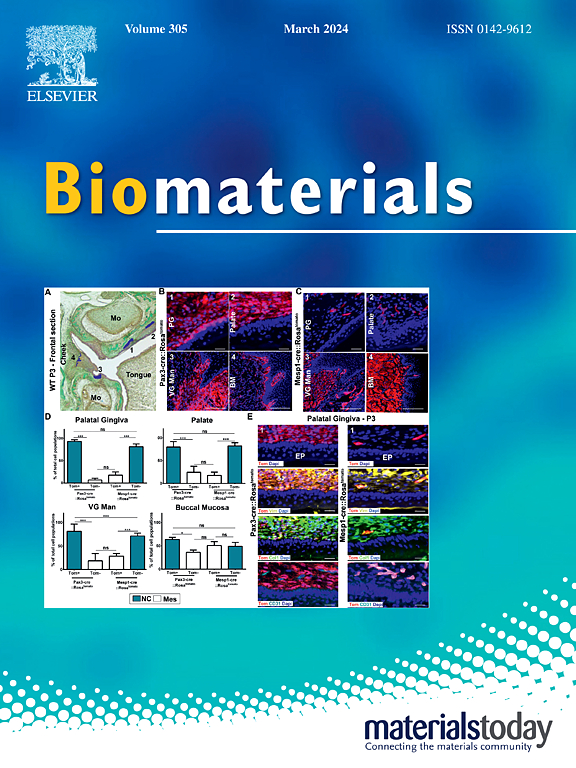自下而上组织工程中液体胶囊的非接触式三维声学装配
IF 12.8
1区 医学
Q1 ENGINEERING, BIOMEDICAL
引用次数: 0
摘要
近年来,大量研究人员致力于开发复制天然组织微结构的系统,提高细胞活力,实现接近天然的细胞组织。尽管各种组装方法取得了进步,但由于某些方法耗时,可扩展性和细胞活力仍然具有挑战性。声学组装已经成为模块化单元组装的一项强大技术,通过微调频率、振幅和腔室几何等参数,利用声波实现快速、非接触式的空间排列。在这里,我们提出了一个系统,利用声波来产生液体核微胶囊的空间模式,封装聚己内酯表面功能化的微颗粒和脐带来源的间充质干细胞。微胶囊是用电流体动力雾化与水两相系统结合生产的,随后包埋在甲基丙烯酸明胶中。然后应用声波在水凝胶前驱体内以明确的模式组装液核微胶囊,然后进行交联以保持结构稳定性。这种方法使我们能够精确地定义空间模式,并与模拟预测保持一致。微胶囊核心的液体性质允许细胞在空间内组织,形成与外部环境分离的微组织。这些有图案的构建物维持了14天的细胞活力,促进了液核微胶囊内微聚集体的形成,并保持了有组织的微观结构。为了探索该系统的多功能性,我们成功地设计并堆叠了多层微胶囊,增加了结构的复杂性。此外,我们通过将人脐静脉内皮细胞植入到构建物上,证明了其支持共培养的能力,作为促进细胞相互作用增强的概念的证明。该平台为开发具有可调复杂性的仿组织多尺度结构提供了可扩展的通用解决方案,实现了快速和非接触组装,使其成为推进体外模型和研究复杂细胞相互作用的宝贵工具。本文章由计算机程序翻译,如有差异,请以英文原文为准。
Contactless 3D acoustic assembly of liquid capsules for bottom-up tissue engineering
In recent years, considerable efforts have been directed towards developing systems that replicate native tissue microarchitecture, enhancing cell viability and achieving close-to-native cellular organization. Despite advancements in various assembly methods, scalability and cell viability remain challenging due to the time consuming nature of certain approaches. Acoustic assembly has emerged as a powerful technology for modular units' assembly, leveraging sound waves to achieve rapid, contactless spatial arrangement by fine-tuning parameters such as frequency, amplitude, and chamber geometry. Here we present a system that employs acoustic waves to generate spatial patterns of liquid-core microcapsules, encapsulating poly-caprolactone surface-functionalized microparticles and umbilical cord-derived mesenchymal stem cells. The microcapsules were produced using electrohydrodynamic atomization in conjugation with an aqueous two-phase system and subsequently embedded in gelatin methacrylate. Acoustic waves were then applied to assemble the liquid-core microcapsules in well-defined patterns within the hydrogel precursor followed by crosslinking for structural stability. This approach allows us to define spatial patterns with precision, aligning with simulation predictions. The liquid nature of the microcapsules’ core permits the organization of cells within the space towards the formation of microtissues decoupled from the external environment. The patterned constructs maintained cell viability for 14 days, facilitating the formation of microaggregates within liquid-core microcapsules and maintained organized microstructures. To explore the versatility of this system, we successfully patterned and stacked multiple layers of microcapsules, increasing structural complexity. Furthermore, we demonstrated its ability to support co-culture by seeding human umbilical vein endothelial cells onto the constructs as a proof of concept for promoting enhanced cellular interactions. This platform offers a scalable, versatile solution for developing tissue-mimetic multiscale constructs with tunable complexity, enabling rapid and non-contact assembly, making it a valuable tool for advancing in vitro models and studying complex cellular interactions.
求助全文
通过发布文献求助,成功后即可免费获取论文全文。
去求助
来源期刊

Biomaterials
工程技术-材料科学:生物材料
CiteScore
26.00
自引率
2.90%
发文量
565
审稿时长
46 days
期刊介绍:
Biomaterials is an international journal covering the science and clinical application of biomaterials. A biomaterial is now defined as a substance that has been engineered to take a form which, alone or as part of a complex system, is used to direct, by control of interactions with components of living systems, the course of any therapeutic or diagnostic procedure. It is the aim of the journal to provide a peer-reviewed forum for the publication of original papers and authoritative review and opinion papers dealing with the most important issues facing the use of biomaterials in clinical practice. The scope of the journal covers the wide range of physical, biological and chemical sciences that underpin the design of biomaterials and the clinical disciplines in which they are used. These sciences include polymer synthesis and characterization, drug and gene vector design, the biology of the host response, immunology and toxicology and self assembly at the nanoscale. Clinical applications include the therapies of medical technology and regenerative medicine in all clinical disciplines, and diagnostic systems that reply on innovative contrast and sensing agents. The journal is relevant to areas such as cancer diagnosis and therapy, implantable devices, drug delivery systems, gene vectors, bionanotechnology and tissue engineering.
 求助内容:
求助内容: 应助结果提醒方式:
应助结果提醒方式:


